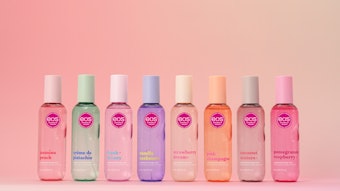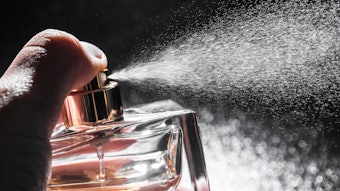Despite the march of technology pushing fragrant options for air care, there is still exceptional power in putting a flame to a simple wick. Candles have held their own in the global air care market against competition from sprays, electronic devices and passive delivery systems.
According to Euromonitor International, the global air care market has been the most dynamic sector in the household care arena since 2001. In 2006, revenues from air care products had increased by more than 35%, reaching $7 billion, and the global air care market is expected to grow to $7.6 billion by 2011.
At a 2006 value of $606 million, candles are the fourth largest global home air care category. Yet, of the seven air care categories considered by Euromonitor, candles had, by far, the largest growth at 13% from 2004–05. The National Candle Association (NCA) estimates annual U.S. retail sales of candles to be $2 billion, excluding candle accessories, a number that includes candles outside of the air care market.
While candles are clearly at home in the air care category, the reasons for their continuing success may lie with elements that are inherent in candles but can’t truly be judged as facets of the category—decor elements, visual and ambient mood enhancers. The performance of candles as a segment, in fact, may be better judged by considering markets other than air care. To illustrate: Blyth, Inc.’s second-quarter 2007 financial release cited weak performance in the U.S. market by its PartyLite division, which markets premium fragranced candles. Blyth board chairman and CEO Robert B. Goergen explained the performance, in part, by noting “the effects of continued weakness in the housing sector, resulting in softness in home decor purchases.”
However, scent is a leading driver of sales, and both manufacturers and consumers tend to be bolder and more experimental with candle fragrances—the tether to the air care category—than with room sprays.
Although it may not be clear at first glance, candles are loaded with value-added features.
“Aerosols and electric air fresheners are leaders in the market right now,” Alexandra Monet, a perfumer with drom Fragrances, told GCI magazine in a December 2006 interview. “But candles are the best to create an atmosphere and perfume a room overall.”
According to the NCA, consumers are increasingly purchasing candles as a focal point for their home decor and purchasing scented candles for mood setting. Nearly half of all American women, according to NCA polls, state they specifically use candles as part of their decorating scheme. The growing popularity of “scenterior” design—combining fragrance and color to create a full sensory aesthetic in the home—is a driving force in candle sales.
Jimmy Belasco—creator of an eponymous candle line among others—views the ethereal qualities of candles as more than aesthetic and mood enhancers, citing his belief that candles are vehicles for spirituality.
NCA data appears to support notions that candles are more than mere ambient artifices, demonstrating that consumers purchase candles for aromatherapy-like relaxation and stress reduction.
In its report on global air care, Euromonitor reports consumers’ changing attitudes toward the home environment are a factor in the growth of the air care market, noting a movement toward creating a more relaxing and welcoming home environment, with candles playing a supporting role and riding on waves of larger trends. Within the air care category, products are impacted by several consumer categories, including fine fragrance and home decor trends.
“These trends are becoming increasingly more important to consumers, as they are interested in more than just a traditional scented candle, but also a product that can help create a pleasing environment in which they can relax,” said Martin Hettich, marketing director, global air care, P&G/Febreze.
Major players in the market have either felt directly the impact of the surge in consumer interest or have taken serious note.
The Yankee Candle Company posted total sales of $277.8 million for 2006’s fourth quarter, a 17.3% increase over the prior year quarter, and total sales for fiscal 2006 of $687.6, a 14.4% increase over fiscal 2005. Total revenue for its first quarter 2007 was $143 million, a 7% increase, and the company continues to grow its distribution channels—including approximately 17,400 store locations and more than 420 company owned and operated retail stores.
After an 87-year absence, Procter & Gamble re-entered the candle market by launching the Febreze Candle throughout the U.S. in July 2007—counting on leveraging the Febreze brand, consumer desire for improved odor elimination and the health of the candle market.
“We have identified a true and compelling consumer need for odor elimination in the candle category. Consumers have told us that they want candles [that] make [their homes] more attractive, comfortable and fresh,” said Hettich. “They also shared with us that current candle offerings were not meeting their needs in terms of controlling odors. Our candles deliver against a currently unmet consumer need, combining a classic method of scenting the home with the odor-eliminating capability of Febreze. Bringing Febreze Candles to the market celebrates innovation on our oldest product, on one of P&G’s newest and fastest-growing brands.”
P&G expects the candle category to continue to grow, both through the entry of new players in the industry and through new product introductions and innovation. First-month sales results demonstrate, according to Hettich, that the launch of Febreze Candles has had a positive influence on the size and growth of the candles category.
Scent and the Retail Connection
The National Candle Association estimates that 80% of all candles sold in the U.S. are scented, and fragrance itself is following broader trends, becoming bolder and more complex. (See the sidebars Popular Scents and Trends for Fall/Winter 2007–2008.)
The gourmand trend inspires food-related scents, including exotic combinations of novel foods and beverages—Er’go, for example, launched green tea, mint tea and chai tea scented candles.
Consumers have also trended toward hard-to-describe but distinctive fragrances; the NCA has labelled this relatively new candle fragrance category “fantasy.”
“We have seen and addressed consumer preferences. They are wanting clean, fresh, green-type fragrances,” said Kathy Flahavin, president and director of product development, Er’go.
But new and trendy must be supported by quality fragrances, regardless of whether the candle is targeted toward a luxury market or not.
“The development and incorporation of new fragrances is a continually evolving process, balancing input and interests from our consumers, as well as ever-changing scenting and fragrance trends within the entire consumer products marketplace,” said Hettich. “More than 10 years of consumer testing in support of Febreze has [made it] a leader in scent delivery through the incorporation of high quality fragrance.”
Fragrance manufacturers continuously formulate air care-specific scents that keep pace with changing consumer tastes and produce scents growing in complexity, allowing marketers to grow lines.
“One of the key challenges within the candle category is to continue to deliver consumer-desired and meaningful innovation,” said Hettich.
Because selling scented products typically requires a first-hand consumer experience, retailers have been integral to the growth of the segment.
According to the NCA, candles are principally sold in three types of retail outlets: specialty or gift shops, department and home decor stores, and mass merchandisers.
“Our retail partners, as with consumers, have been an integral and critical partner in the launch of Febreze Candles,” said Hettich. “As our in-store presence is the first ‘moment of truth’ for our consumers, getting the delivery and execution right requires early involvement and collaboration with all of our retail partners, who play a critical role in each of our product launches. Following the product launch, we maintain this relationship with the trade, to ensure that our product continues to deliver best-in-class performance and value for the consumers they serve.”
“We listen to customer requests. This is one reason that bricks and mortar retailers will always be important to our industry,” Ardene Flahavin, vice president and director of marketing, Er’go. “The Web is a great place to get information as well as education about many products, but people still want to be able to see, feel, touch and, most important, smell the fragrance of the candles.”
The feel and fragrance of candles provide an ambiance that will continue to appeal to consumers well into the future.
Additional Euromonitor International global air care data is available online. For Mintel International Group’s synopsis of candle fragrance trends, see Candle Fragrances: Natural, Fruit and Florals.
Additional candle data is available on the National Candle Association’s Web site,
www.candles.org.
Back to the October issue.










